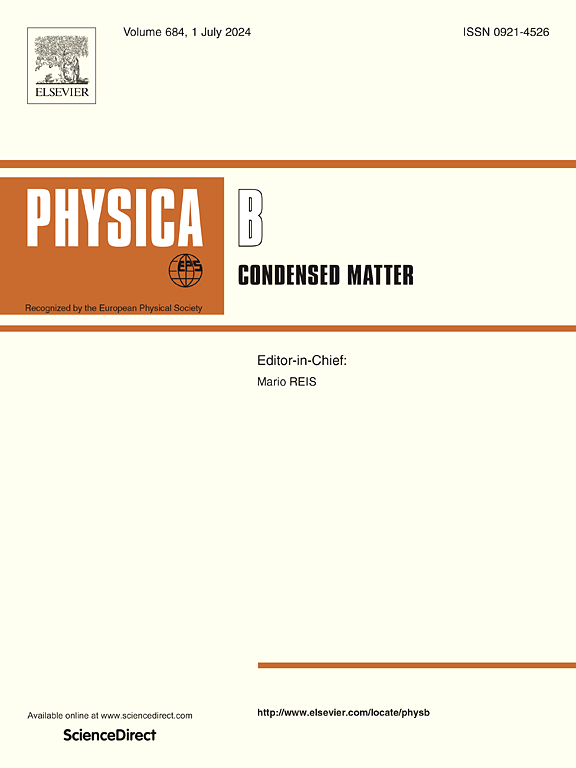Optoelectronics, mechanical and thermoelectric properties of wide-band-gap semiconductors MgXS: X= Cd, Zn in the non-magnetic rock salt phase
IF 2.8
3区 物理与天体物理
Q2 PHYSICS, CONDENSED MATTER
引用次数: 0
Abstract
Utilizing the linearized augmented plane wave method within the wien2k package, based on Density Functional Theory (DFT) calculation, we investigate the structural, mechanical, electronic, optical, and thermoelectric properties of the semiconductor compounds Mg0.875 × 0.125S (X = Cd, Zn) in their non-magnetic rock salt structure of type (B1) and space group Fm m (225). We calculate the structural and mechanical properties using the WC-GGA approximation, evaluate the electronic and optical properties using the TB-mBJ approximation, and determine the thermoelectric properties using the Boltztrap code.
The obtained elastic constants, Pugh ratio, and bulk modulus B (GPa) indicate that the compounds Mg0.875 × 0.125S (X = Cd, Zn) are fragile yet mechanically stable.
Moreover, the Debye temperature θD (K) of binary compound MgS is high, at 772.90 K. The energy gap values for MgS, Mg0.875Cd0.125S, and Mg0.875Zn0.125S equal 4.043 eV, 3.09 eV, and 2.82 eV, respectively. When we go from binary MgS to the ternaries containing Cd and Zn respectively, The gap moves from the ultraviolet region to the visible region. The wide band gap of the compounds constitutes an advantage for their applications in optoelectronics and photovoltaics. The compounds studied exhibit an intense peak in the ultraviolet region in the spectra of the real and imaginary parts of the dielectric constant, the absorption coefficient α(ω), and the optical conductivity σ(ω), suggesting promising opportunities for optoelectronics applications. The study of thermoelectric properties of compounds has shown that they are interesting from this point of view because of the significant values of their figures of merit (ZT).
宽带隙半导体MgXS: X= Cd, Zn在非磁性岩盐相中的光电子学、力学和热电性能
利用wien2k封装中的线性化增广平面波方法,基于密度泛函理论(DFT)计算,研究了半导体化合物Mg0.875 × 0.125S (X = Cd, Zn)在类型(B1)和空间群f3_ m(225)的非磁性岩盐结构中的结构、力学、电子、光学和热电性质。我们使用WC-GGA近似计算了结构和力学性能,使用TB-mBJ近似评估了电子和光学性能,并使用Boltztrap代码确定了热电性能。得到的弹性常数、Pugh比和体积模量B (GPa)表明,化合物Mg0.875 × 0.125S (X = Cd, Zn)具有脆性和力学稳定性。此外,二元化合物mg的德拜温度θD (K)较高,为772.90 K。mg0.875 cd0.125 5s和mg0.875 zn0.125 5s的能隙值分别为4.043 eV、3.09 eV和2.82 eV。当我们从二元MgS到分别含有Cd和Zn的三元时,间隙从紫外区移动到可见光区。该化合物的宽带隙为其在光电子学和光伏学中的应用提供了优势。在所研究的化合物中,介电常数实部和虚部、吸收系数α(ω)和光电导率σ(ω)的光谱在紫外区表现出一个强峰,表明其光电子应用前景广阔。对化合物热电性质的研究表明,从这个角度来看,它们是有趣的,因为它们的优点值(ZT)很重要。
本文章由计算机程序翻译,如有差异,请以英文原文为准。
求助全文
约1分钟内获得全文
求助全文
来源期刊

Physica B-condensed Matter
物理-物理:凝聚态物理
CiteScore
4.90
自引率
7.10%
发文量
703
审稿时长
44 days
期刊介绍:
Physica B: Condensed Matter comprises all condensed matter and material physics that involve theoretical, computational and experimental work.
Papers should contain further developments and a proper discussion on the physics of experimental or theoretical results in one of the following areas:
-Magnetism
-Materials physics
-Nanostructures and nanomaterials
-Optics and optical materials
-Quantum materials
-Semiconductors
-Strongly correlated systems
-Superconductivity
-Surfaces and interfaces
 求助内容:
求助内容: 应助结果提醒方式:
应助结果提醒方式:


